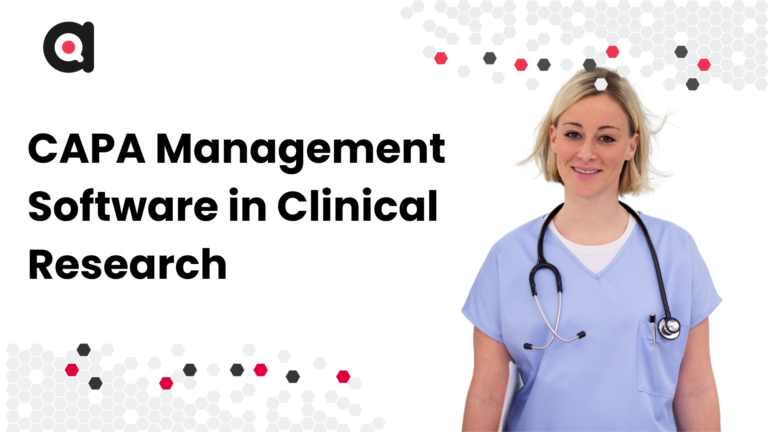What is CAPA Management Software in Clinical Research?
Table of Contents
ToggleAQ

CAPA Management Software in clinical research is designed to implement Corrective and Preventive Actions, addressing compliance issues to prevent recurrences. This software ensures participant safety, protects their rights, and maintains data integrity. It streamlines clinical trial processes, enhancing project quality through proactive issue resolution and preventive measures for better, compliant workflows.
Let’s discuss in detail what CAPA management software is and what it entails for clinical trial researchers.
Corrective and Preventive Action (CAPA) in Clinical Trial Research
CAPA is a systematic approach designed to help clinical researchers address and rectify issues that arise during the trial. It is crucial for maintaining the quality, integrity, and compliance of clinical trials.
Clinical researchers can leverage powerful CAPA software to streamline and enhance their corrective and preventive action processes. This software offers a centralised platform for efficiently managing and documenting every step of the CAPA workflow.
Here’s how CAPA Software helps in clinical research:
CAPA Features | Contribution to Clinical Research |
Identification of Issues | Systematically identifies issues or non-compliance during trials. |
Root Cause Analysis | Conducts in-depth analysis to identify the root causes of issues. |
Corrective Actions | Promptly and effectively address identified issues. |
Preventive Actions | Proactively mitigate the recurrence of similar issues in future trials. |
Training and Communication | Provides training to prevent similar issues and communicates lessons learned. |
Monitoring and Evaluation | Regularly monitors and evaluates everything to ensure sustained improvements and compliance. |
How CAPA Management Software Works?
CAPA Management Software in clinical research digitizes and automates the Corrective and Preventive Action process. It allows launching forms from complaints, deviations, audits, and more, providing full visibility into the CAPA process. This enables data analysis and trend identification to improve quality management. The software helps researchers systematically identify issues, analyze root causes, develop action plans, and monitor progress in real-time, ensuring proactive problem prevention and resolution.
Here’s what CAPA management software do:
- Systematic detection of deviations, errors, and issues within the clinical research process, along with prompting the reporting mechanisms for researchers to highlight potential concerns.
- Comprehensive documentation of identified issues, analyses, and actions taken with detailed reports for internal use, regulatory compliance, and audits.
- Timely and targeted interventions to restore compliance and data integrity.
- Proactive measures to identify and mitigate potential issues before they occur.
- Alignment of CAPA processes with overall risk mitigation strategies in clinical research.
- Learning from past experiences and applying insights to refine research processes.
- Structured workflow to guide users through the CAPA process, ensuring consistency through assignment of responsibilities and tracking of progress at each stage.
- Tools for effective communication and collaboration among team members involved in CAPA processes.
- Use of statistical tools to identify recurring issues or deviations.
- Alignment with regulatory standards and guidelines such as Good Clinical Practice (GCP) while ensuring that CAPA processes meet the requirements of relevant regulatory bodies.
- Integration with training modules to ensure that staff is adequately trained in CAPA procedures.
- Support for collaboration with external partners, such as contract research organisations (CROs) or regulatory agencies, in the CAPA process.
- Use of performance indicators to assess the effectiveness of CAPA processes over time.
- Ensuring that CAPA processes contribute to the overall readiness of the organisation for regulatory scrutiny.
The formula for ORR calculation in clinical trials is:
ORR = (CR+PRTotal Evaluable Patients) / RR = ( Total Evaluable Patients CR+PR ) ×100
Considering an Example to Understand the Use of CAPA Software
Let’s suppose that a clinical research organisation is conducting a multi-site clinical trial to evaluate the efficacy and safety of a new drug. During a routine monitoring visit, the monitors identify a recurring issue across several study sites. The issue is related to data entry errors in the electronic case report forms (eCRFs) that could impact the accuracy of the trial results.
Here’s how CAPA management software helps the clinical researchers:
Issue Identification
The monitors identify the data entry errors during their routine monitoring visits, noting the specific sites and instances where the errors are occurring.
Root Cause Analysis
The organisation conducts a root cause analysis to determine why the data entry errors are happening. It is discovered that there was a lack of standardised training for site personnel
responsible for data entry.
Corrective Action (CA)
Immediate corrective actions are taken to address the data entry errors. The organisation provides targeted training sessions for the site personnel on proper data entry procedures and establishes a system for real-time data validation checks.
Preventive Action (PA)
As a preventive measure, the organisation revises its training program to include standardised training for data entry procedures for all future clinical trials. This proactive step aims to prevent similar issues from arising in future studies.
Continuous Improvement
The organisation reviews its data entry procedures and implements enhancements to the electronic data capture (EDC) system, making it more user-friendly and reducing the likelihood of errors. This reflects a commitment to continuous improvement in data management processes.
Documentation
All corrective and preventive actions are thoroughly documented, including details of the training sessions, system enhancements, and any additional measures taken to address the issue. This documentation serves as evidence of the organisation’s commitment to quality and compliance during regulatory inspections.
Feedback Loop
The organisation establishes a feedback loop by monitoring subsequent monitoring visits and conducting internal audits to assess the effectiveness of the implemented corrective and preventive actions. Any further issues are promptly addressed through additional CAPA measures.
So in this example, CAPA is used to address an identified issue, investigate its root cause, implement immediate corrective actions, and establish preventive measures to enhance data quality in future trials. The organisation’s commitment to continuous improvement and documentation ensures ongoing compliance with regulatory standards while contributing to the overall success of its clinical research activities.
CAPA Implementation Challenges
Implementation of CAPA software in clinical research comes up with challenges that demand thoughtful navigation. Accurately pinpointing root causes, ensuring timely issue reporting, and overcoming resource constraints are hurdles that require strategic solutions. Resistance to change, communication hiccups, and technology limitations add to the complexity on different levels. Whereas balancing regulatory compliance demands and establishing effective metrics for CAPA evaluation present ongoing challenges.
Navigating all these challenges with a proactive and collaborative approach is essential for successfully integrating CAPA in the clinical research practices.
Integrating CAPA with CTMS: Should You Do it?
Integrating Corrective and Preventive Action (CAPA) software with Clinical Trial Management Systems (CTMS) is a strategic decision, which offers the following benefits:
- Centralised issue tracking for easy management.
- Real-time insights into ongoing corrective actions and preventive measures.
- Enable seamless communication among stakeholders for prompt information flow.
- Automated workflows within CTMS to reduce manual tasks.
- Aligned risk management strategies with CAPA to proactively mitigate risks.
- Systematic approach to issue resolution for enhanced compliance.
- Customised reports and analytics for data-driven decision-making.
- Complete and traceable records for audit readiness.
- Training initiatives linked directly to corrective actions for personnel competency.
- Historical data for continuous improvement in clinical research processes.
You may use a powerful clinical trial management system like AQ Trials, an all-in-one platform that combines the capabilities of CTMS and CAPA to offer an integrated solution. It also integrates other important clinical trial software, such as eISF and eDel for an improved research experience.
Final Words
CAPA software stands as a crucial asset in clinical research, offering a robust framework for identifying, addressing, and preventing issues throughout the research process. Its versatility allows for both standalone use and seamless integration with systems like CTMS. All while ensuring data integrity and participant safety.
Related Articles

Industry News
The Ultimate Guide to Understanding What is a CTMS
A Clinical Trial Management System (CTMS) is a specialised, all-encompassing project management software tailored to guide a research team from the study’s inception—through the enrolment and oversight phases to the study’s conclusion…
AQ

Industry News
How Long Do Clinical Trials Take?
Objective Response Rate (ORR) in clinical trials is the proportion of patients demonstrating either a partial response (PR) or a complete response (CR) to a specific treatment. It excludes stable disease and provides a direct quantitative measure of the treatment’s ability to induce a meaningful reduction or elimination of tumours.
AQ
